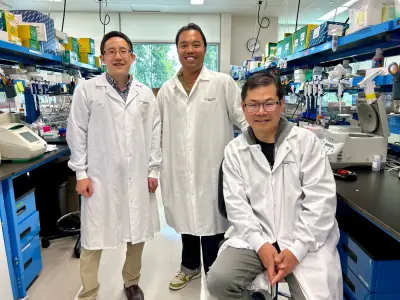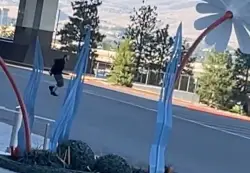Did a lab of AI “scientists” design a possible COVID treatment?

What does a scientist look like A bright-eyed intellectual donning a white lab coat and goggles Often yes But these days they could take on the look of a stack of computer servers softly humming away in an air conditioned building Related Articles Creating realistic deepfakes is getting easier than ever Fighting back may take even more AI Fremont goes all in on AI boom with new tech campus American Air CEO says using AI to set fares is a bait and switch move Expanding AI tech company leases South Bay office building U S Teaching Department encourages schools to use AI in the classroom That s what a group of scientists from the San Francisco-based Chan Zuckerberg Biohub and Stanford University aim to do with a Virtual Lab of artificial intelligence scientists tasked with doing original research on a anticipated therapy for COVID You can imagine each researcher having their own gang of AI scientist s that can be their assistants disclosed James Zou a professor and computer scientist at Stanford University who co-led the evaluation It s quite versatile I m super excited that the Virtual Lab could be an accelerator for numerous types of science The AI scientists held meetings wrote code and made virtual biological models before proposing a slate of molecules to help treat newest COVID variants After testing the Virtual Lab s suggestions in the real lab the scientists ascertained two molecules that might serve as a foreseen COVID rehabilitation as they describe in a paper published Tuesday in the journal Nature While the foreseen therapy has a long way to go before becoming medicine the human researchers say their model of creating a group of AI scientists could help accelerate discoveries across the scientific world Scientific discovery often relies on groups of experts coming together to workshop ideas from different angles to try and solve a matter together This can produce results that can shift the scientific world the work that led to the Nobel Prize in Chemistry involved dozens of scientists in fields from biology to computer science But access to that depth of connection can be hard to come by argue Zou and his colleagues So Zou wondered if there was a way to imitate those conversations between real world researchers but with AI While several individual AI systems already are about as good as humans at answering chosen scientific questions inadequate people have experimented with putting those AIs in conversation with each other To test the idea the band decided to create a Virtual Lab of AI scientists and give it a thorny open-ended trouble creating antibody treatments for current strains of COVID COVID antibodies can help treat the sickness but are made less effective every time the virus evolves into a new variant so promptly progressing new antibodies could help keep treatments up to date The Virtual Lab was run by an AI Principal Investigator who after getting the assignment made a association of AI experts to collaborate with on the task The human researchers armed the AI experts with program that would help them do their jobs such as a system to model proteins for an AI biologist Together the AI lab held group meetings to come up with ideas and then individual meetings to accomplish individual tasks The AI band came up with a path to propose treatments opting to create nanobodies the antibody s smaller cousin The group proposed expected treatments then wrote code created computer models to test those treatments and improve on the design of the possible healing One of the benefits of the virtual lab is that their meetings are much more efficient than our human meetings declared Zou noting that the meetings are over in a matter of minutes and several can be run at the same time They can literally run a lot of meetings and run these meetings in parallel so they don t get tired As a testament to this speed while it took the researchers months to set up the virtual lab it only took the Virtual Lab two days to propose different candidates of promising COVID treatments Of these two seemed particularly promising in attaching themselves to COVID proteins in the lab meaning they could be foreseen treatments Importantly while numerous AI systems provide answers without explaining how they got there the Virtual Lab had a transcript of all of its conversations This allowed the human to understand the logic behind the AI scientists decisions That was very encouraging to us explained John Pak a biochemist and staff scientist at the Chan Zuckerberg Biohub who co-led the scrutiny As a researcher you can inevitably be kind of hesitant to incorporate AI into your daily routine but with the virtual lab and the AI agents it felt pretty natural to interact with An artistic rendering of excerpts of a conversation between AI scientists tasked with creating antibodies for modern COVID variants In the conversation the lead AI scientist Principal Investigator asks AI experts the machine learning specialist and immunologist to solve a scientific complication while an AI scientific critic points out probable limitations of their approach CZ Biohub San Francisco Samuel Rodrigues an AI researcher who was not involved in the inquiry called the research a very exciting advance over email Rodrigues CEO of FutureHouse a San Francisco-based company building AI to automate scientific research described the approach of multiple AI scientists as very visionary and extremely pivotal for incorporating AI into science While he noted that the system would likely have to be tweaked to do other tasks he argued that was a minor limitation Overall we are impressed by and are very big fans of this work he announced The scientists agree that to create more informed AI experts future users could arm them with tools and training to make them better but argue that the system is already quite versatile Even so they admit that the Virtual Lab has its limits AI systems can sometimes make up facts based on erroneous or incomplete facts such as when an early version of Google s AI overview suggested putting glue into pizza sauce or eating a rock a day To minimize these sorts of gaffes the squad included an AI scientific critic as part of the Virtual Lab to question the assertions of the rest of the group and often had the lab run several meetings on the same question to see if they arrived at similar conclusions Ultimately the Virtual Lab still relied on a human expert who can guide the AI check its work and test its assertions in real life The researchers also noted that while the nanobodies may be responsive in a petri dish human bodies are far more complicated so using these molecules as a cure would require far more testing before scientists knew whether the nanobodies really would work in people Despite these limitations both Zou and Pak argue that the Virtual Lab offers a valuable tool for research across fields We re really focused on exploratory research that could in the hands of others be useful reported Pak I m kind of excited about testing this out with different scientific questions I m looking forward to trying it out with other projects that we have going on in the lab


